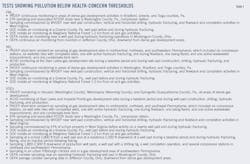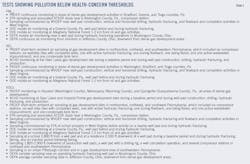Air emission data show safety of US Northeast shale work
Kathy Condo
Babst Calland
Pittsburgh
Kathryn Klaber
The Klaber Group
Sewickley, Pa.
Abbreviation key
ATSDR-Agency for Toxic Substances and Disease Registry (US Department of Health and Human Services)
ACHD-Allegheny County Health Department
DOE-US Department of Energy
EPA-US Environmental Protection Agency
NAAQS-National ambient air quality standard
NETL-National Energy Technology Laboratory
NO2-Nitrogen dioxide
OEPA-Ohio Environmental Protection Agency
PADEP-Pennsylvania Department of Environmental Protection
PAH-Polycyclic aromatic hydrocarbon
PM2.5-Fine particulates (less than 2.5 μm)
VOC-Volatile organic compound
WVDEP-West Virginia Department of Environmental Protection
Air emissions data from actual monitoring and testing contradict articles based on different methods claiming to have found health hazards related to oil and gas work. Data collected by objective parties in the northeastern US over the past 6 years indicate that air quality around oil and gas operations is, in fact, safe. This observation contrasts starkly with arguments made in a variety of published studies cited by opponents of domestic shale development.
A casual review of studies not based on actual data would lead many readers to assume that emissions haven't been tested and that a health threat looms. In fact, much testing information exists, but most of it has been compiled by regulatory agencies with few incentives to publish the results and promote them to the media.
Actual air emissions data have been collected in 15 air-monitoring and testing studies by objective third parties. The parties, in some cases working jointly, include the Allegheny County Health Department, Pennsylvania Department of Environmental Protection, Ohio Environmental Protection Agency, US Environmental Protection Agency, US Department of Health and Human Services Agency for Toxic Substances and Disease Registry, Techlaw, West Virginia University for the West Virginia Department of Environmental Protection, and US Department of Energy National Energy Technology Laboratory (Table 1 and abbreviation key). In addition, measurements of air quality have been documented in studies by research groups led by J.R. Maskrey, J.F. Goetz, R.F. Swarthout, and L.B. Paulick (Table 2).
What tests show
These tests and studies measure concentrations of fine particulate matter, nitrogen dioxide, volatile organic compounds, polycyclic aromatic hydrocarbons, and ozone. None of the assessments reveals concentrations constituting health concerns.
PAH data have been collected, without concentrations indicating health concerns, via sampling at 23 properties in Carroll County, Ohio, within 210-16,900 ft of an active gas-well pad.
Continuous ozone monitoring in counties of Pennsylvania with extensive gas development (Washington, Bradford, and Greene) reveals no increases-and, in most instances, decreases-in ground-level ozone as gas development has expanded and no exceedances of the ozone national ambient air quality standard. Continuous ozone monitoring data in Jefferson County, Ohio, near and downwind from areas of dense gas development, show no exceedances of the ozone NAAQS and no historical increases in ground-level concentrations.
Fundamental difference
Agency-led studies differ fundamentally from the many that claim adverse health effects: The agency-led studies include actual air emissions monitoring and testing. The others include one or more of the following approaches:
• Literature reviews. A number of authors have published articles consisting of reviews of other published articles from which they draw conclusions.
Among articles of this type is the review of chemicals, which lists chemicals that may in some way be used in unconventional natural gas development, followed by a list of the potential health effects of these chemicals with no exposure analysis. The authors do not evaluate actual emissions or exposure data for any of these chemicals.
Another type of literature review summarizes articles discussing health effects. Many literature reviews discuss the potential for overall, rather than specific, health effects.
• Surveys of self-reported symptoms. Many articles claiming adverse health effects from gas development report on surveys of subjective health symptoms among community members living in the area of gas development. Survey participants often are self-selected, and the studies rely on these reports without medical verification. The reported health complaints are subjective and consist of very common symptoms (e.g., headaches, stress, nausea, rashes, sinus problems), all of which have many causes. None of these studies conducts an appropriate statistical analysis of health effects based on exposure.
• Studies based on exposure assumptions. Studies that have looked at the incidence of certain health conditions based on proximity to well pads (exposure surrogates) rather than on actual exposures have significant limitations. They are at best hypotheses-generating studies, which are not supported by the actual air data.
Overall safety
Additional monitoring and testing may be warranted for specific purposes, but data collected to date establish that air quality near shale operations in the northeastern US meets safety standards. The evidence from 6 years of data collection is overwhelming.
This conclusion should be welcome news to the region's residents, public officials, and the many Americans who benefit from affordable energy supplied by a region of rapid production growth.
The authors
Kathy Condo is a shareholder in the Litigation Services Group of law firm Babst Calland, handling toxic tort and products liability litigation in various federal and state courts, often with numerous technical and medical expert witnesses. She has become involved in counseling clients in threatened toxic tort litigation related to Marcellus shale development and defending these cases when filed. A graduate of Pennsylvania State University, Condo holds a J.D. from Duquesne University School of Law. She is admitted to practice in Pennsylvania and West Virginia and is a member of the Allegheny County Bar Association.
Kathryn Klaber leads The Klaber Group, a consultancy providing strategic services to businesses and other institutions involved in shale development in the US and elsewhere. Her career includes 10 years in environmental consulting and 7 years with a chief executive-led economic development, policy, and advocacy organization. She is the founding chief executive officer of the Marcellus Shale Coalition. Klaber earned her undergraduate degree in environmental science from Bucknell University and her master's degree in business administration from Carnegie Mellon University, where she received the Enterprise Award for Entrepreneurship.


